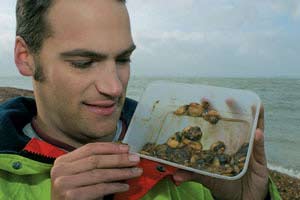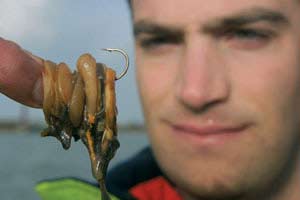The water was the colour of tea and the surf was rolling in along the nearby East Winner Bank. There were slipper limpet shells littered everywhere – shells that had been washed up on Hayling Island beach by the storm that had hit the area just two days ago. Unbelievably, there was no-one else fishing, despite the fact that conditions looked absolutely ideal for bass.
I asked Tom Foster, who has fished the beaches in this area for many years, whether we had timed our visit well. “I think so,” he said. “The water is well-coloured and the fact there are fresh slipper limpets all over the beach bodes well. Conditions look good – we should catch well because we’re fishing just after a good southerly blow. The bass should be close in, feeding on limpets that were washed out of their shells during the storm. We’ll probably get most of our bites about 15 yards out, because that’s where most of the bass’s food will be.
“People might think it’s strange that I fish so close in, but I’ve seen a lot of anglers fish here after an onshore gale and really whack their baits out. They’ve looked at me strangely when I turn up and lob a 3oz running lead rig 10 to 15 yards out, just beyond the waves, but if that’s where the fish are that’s where you need your bait. Even when they see me catching they won’t cast close enough in to increase the number of bites they get.” I couldn’t argue with the logic. It was just a case of hoping Tom was right – would the bass really be that close in following the storm? I hoped so as I threaded my line through the rings of the carp rod Tom had told me to bring along.
“If conditions have calmed down enough, and I can get away with it, I like to use a carp rod for this style of fishing,” explained Tom. “Most of the fish you catch on limpets are in the 1lb 8oz to 2lb 8oz class, though I have had them to nearly 5lb, so lighter tackle gives you better sport. “The sensitive rod tips also allow you to feel the bites more effectively. You might think that the bites you get would pull the rod tip right over. Sometimes they do, but on other occasions the bass can be really finicky and gently ‘tap’ at the bait. At times like that a carp rod is a real advantage and helps you time your strike to hit the fish at just the right moment.
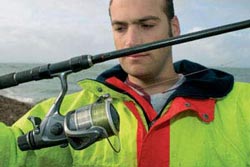 |
| Tip One….. Take a carp rod with you. If conditions allow, this will give better sport than a beachcaster. |
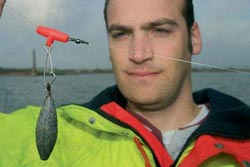 |
| Tip Two….. Tom’s lead system! You only need to cast 15 yards, so there’s no need for a shockleader or bait clip. |
“Carp rods do have limitations, though. On this mark, you can only use the rod for an hour or so either side of slack water. At other times the tide is too strong. Also, if there’s a big swell coming in from the preceding storm, you might need to use a beachcaster with a 5oz grip lead to hold the bait in place. “Today we’re lucky. The sea has flattened off nicely and a carp rod should be fine over high water.”
Within 10 minutes of arriving at his chosen mark, between Hayling Island ‘s funfair and the Winner Bank, Tom was ready to make his first cast of the day. Just before he did, though, I took a sneaky look at his rig – and was amazed by its simplicity. It consisted of a 3oz running lead (not a grip lead) placed on a boom. The 4ft trace was made from 15lb mono, with the hook being a size 1 Kamasan B950 Uptide pattern.
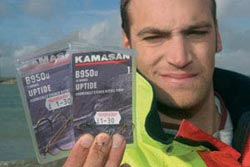 |
| Tip Three….. Use size 1, 1/0 or 2/0 uptide hooks. They should be fine-wired patterns and very sharp! |
Tom holds his carp rod while waiting for a bite, but a tripod is useful if conditions mean you have to use a beachcaster.
As well as using a simple rig, Tom’s method of putting limpets onto the hook is also about as basic as you can get – he just piles seven or eight of the shellfish onto the hook and casts out! Forget bait elastic, the finished hook bait ends up looking like a pile of smelly mush. Surely, I thought to myself as I watched him cast out, he won’t get a bite on that. The presentation was simply too poor.
But I was wrong, and within a minute of casting out Tom had a rip-roaring bite! As he struck into the first bass of the day, I knew we would catch a lot of fish – conditions were absolutely spot-on for it. Tom’s bass put up a great scrap on the carp rod, even though it was only 1lb 8oz in size. And sure enough, it had been hooked fairly and squarely in the lip, just as he’d said it would be – the pile of limpets it had tried to eat hanging out over the corner of its mouth. As Tom put the bass back, I asked him again about his bait presentation.
“Why bother spending time wrapping the limpets up in bait elastic?” he said. “When the fishing is really switched on here, you can get bites within a minute of casting out, every cast. If you spent time fiddling with bait elastic you’d get less bites because your rig would spend more time out of the water. “Doing this, I can rebait in seconds and get the rig back in the sea. And because the water is so coloured, the bass aren’t hunting by sight. They find the limpets using their sense of smell.” I must admit that the limpets Tom had brought with him in a Tupperware box did, indeed, smell pretty rank. They were soaking in their own juices and looked almost half-decomposed. Surely fresh bait
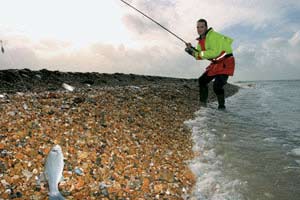 |
| A 2lb 8oz bass – fish of this size are common in the right conditions. |
was best, I asked?
“I’ve set off to go fishing here without any bait on loads of occasions,” admitted Tom. “When I arrive I just pick the limpets off the beach, shell them and put them on the hook. “Limpets straight out of the water like this catch plenty of bass, but I always find that half-rotten limpets catch more. That’s why, after every storm, I take a bucketful of limpets back to my flat and shell them in the kitchen. I then store them in Tupperware boxes and leave them for a couple of days before either fishing with them or salting them down and freezing them. “Limpets that have been left to rot for three days may smell absolutely disgusting to us, but the bass seem to find them quicker. Bass love smelly limpets,” rounded off Tom with a smile on his face. Just don’t visit his flat a couple of days after a southerly gale!
Following the success of his first cast, Tom went on to get a bite every chuck for the next 20 minutes as the tide reached its highest level. Because I’d been taking photos continuously, I didn’t have the chance to make a cast until high water – but seeing Tom bagging fish to over 2lb 8oz on the carp rod really fuelled my appetite, so I put the camera down and had a go myself. I didn’t bother putting the rod on a rest after I’d cast out, though. Instead I held it, feeling the line for any sign of a bite. When that bite came, it was unmissable! The rod tip rattled a couple of times before slamming round. I didn’t need to strike because the fish hooked itself, and I leant into a bass that started to give me the runaround on the light tackle I was using. A minute later I had a prime fish of around 2lb 8oz lying on the shingle in front of me. I unhooked it and slipped it back, much to Tom’s surprise! “I thought you’d have kept that one,” he said. “For this time of year that’s not a bad fish. I don’t think we’ll get many bigger than that today.”
|
|
I was interested that Tom said it was a decent fish for the time of year. Did that mean you can catch bigger bass on limpets at a different time of year? “Limpets catch bass after storms here nearly all year round,” answered Tom, “but the best time of year is definitely October through to January. By late January the water gets a bit cold for the bass and they disappear for a month or so, but November, December and early January can be very good indeed. In fact, I’ve caught some excellent bags of fish on Boxing Day and New Year’s Eve, when we’ve had a stormy Christmas holiday. As long as the water’s coloured and there are fresh limpets on the beach, the bass will be around. “The bigger fish tend to appear later in the year, too. I’ve found that late November and December is best for the larger bass, with fish over 3lb fairly common. Like I said, my biggest limpet-caught bass weighed nearly 5lb – though I have never heard of anything bigger being caught on limpets. It’s as though the really big bass don’t feed on them.”
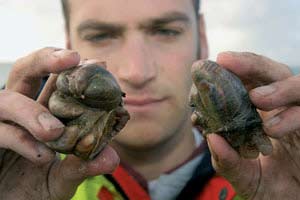 |
| Tip One….. This is what you are looking for – a group of limpets fresh from the sea, stuck together in a little colony. |
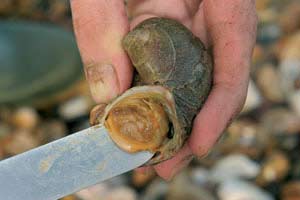 |
| Tip Two….. Using a blunt knife, shell the limpets like this. The meat you can see in the shell makes a great bass bait. |
As this conversation carried on, Tom and I continued fishing – beaching bass at regular intervals. Then, suddenly, the bites dried up. But Tom had an answer to that! He simply picked up his gear and walked along the beach 50 yards or so, where there seemed to be more waves breaking. “I’m just moving to an area of slightly shallower water,” said Tom. “Sometimes you need to move down the beach. If you’re not catching anything in one spot, a move will often put you straight on fish. Also, if you’re catching a lot of small bass around the 1lb mark, moving can put you onto bigger fish.”
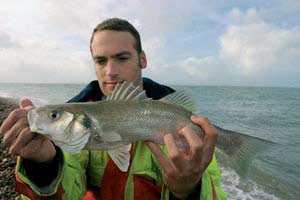 |
| You’ll find that most of the bass bites will come from just 15 yards out! |
Tom’s expertise paid off as, straight after casting in, we were back into fish again. By the end of the three-hour session I’d had around 30 bass – goodness knows how many Tom had caught and returned! He’d kept two for the pot, as he said he would – both of which were around 2lb 8oz in size. Although most of the bass we caught were undersized – fish of between 12oz and 1lb 8oz – they were great fun and prove that good sport can be had on the UK ‘s beaches while using light tackle.
The only thing you have to remember when it comes to using slipper limpets for bass is to make sure you time your trip right. You must fish after an on-shore gale. Don’t cast out too far (often 20 yards is too far) and don’t be afraid to use really, really smelly limpets on the hook. As a measure of how smelly Tom’s limpets were, I could still smell the bloody things on my hands two days after the session had finished! No wonder the bass could find them so quickly in the coloured water. So, the next time you see a weather warning for your coastline, forecasting storms and onshore gales, plan a bass trip – and give ‘em a slipper on the end of your line!


![slipper-15[1].jpg](https://www.total-fishing.com/wp-content/uploads/2011/04/slipper-15[1].jpg)
